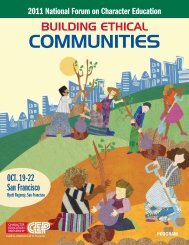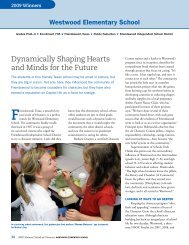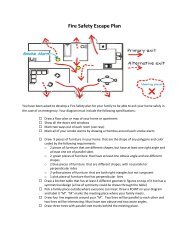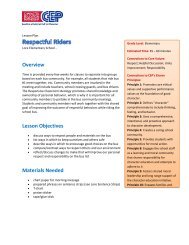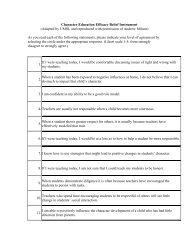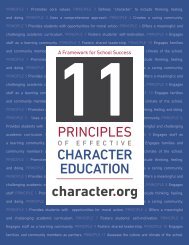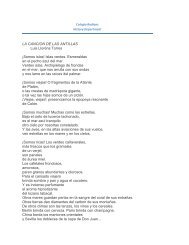What works in character education: A report for policy makers and
What works in character education: A report for policy makers and
What works in character education: A report for policy makers and
You also want an ePaper? Increase the reach of your titles
YUMPU automatically turns print PDFs into web optimized ePapers that Google loves.
<strong>What</strong> Works In Character Education:<br />
A <strong>report</strong> <strong>for</strong> <strong>policy</strong> <strong>makers</strong> <strong>and</strong> op<strong>in</strong>ion leaders<br />
Character Education Partnership<br />
Marv<strong>in</strong> W. Berkowitz, Ph.D.<br />
Mel<strong>in</strong>da C. Bier, Ph.D.<br />
University of Missouri-St. Louis<br />
February 2005<br />
John E. & Frances G. pepper
This <strong>report</strong> was made possible by a lead grant to CEP from the John Templeton<br />
Foundation <strong>and</strong> with the generous support of 3M Foundation, The Procter &<br />
Gamble Company, <strong>and</strong> John E. <strong>and</strong> Frances G. Pepper. The op<strong>in</strong>ions expressed<br />
<strong>in</strong> this <strong>report</strong> are those of the authors <strong>and</strong> do not necessarily reflect the views of<br />
the John Templeton Foundation or the other sources of f<strong>in</strong>ancial support.<br />
The Character Education Partnership (CEP) is a nonpartisan national coalition of<br />
organizations <strong>and</strong> <strong>in</strong>dividuals, based <strong>in</strong> Wash<strong>in</strong>gton, DC, dedicated to develop<strong>in</strong>g young people<br />
of good <strong>character</strong> who become responsible <strong>and</strong> car<strong>in</strong>g citizens.<br />
The University of Missouri-St. Louis’ (UMSL) School of Education has the only endowed chair<br />
<strong>for</strong> <strong>character</strong> <strong>education</strong>. UMSL resources <strong>in</strong>clude a <strong>character</strong> <strong>education</strong> library consist<strong>in</strong>g of<br />
well over 10,000 resources related to the development of <strong>character</strong> <strong>in</strong> children, adolescents, <strong>and</strong><br />
adults, the <strong>What</strong> Works <strong>in</strong> Character Education Advisory Board (an <strong>in</strong>terdiscipl<strong>in</strong>ary panel of<br />
national experts from <strong>character</strong> <strong>education</strong> <strong>and</strong> related discipl<strong>in</strong>es), <strong>and</strong> the equipment <strong>and</strong><br />
facilities of the Des Lee Technology Learn<strong>in</strong>g Center.<br />
Please send your comments to:<br />
Merle Schwartz<br />
Director of Education <strong>and</strong> Tra<strong>in</strong><strong>in</strong>g, Character Education Partnership<br />
mschwartz@<strong>character</strong>.org<br />
Fax: 202-296-7779<br />
Marv<strong>in</strong> Berkowitz<br />
berkowitz@umsl.edu<br />
Fax: 314-516-7356<br />
402 Marillac Hall<br />
University of Missouri- St Louis<br />
St. Louis MO 63121-4499<br />
This publication is available from the:<br />
Character Education Partnership<br />
1025 Connecticut Ave., Suite 1011<br />
Wash<strong>in</strong>gton, DC 20036<br />
202.296.7743 or 800.988.8081<br />
fax: 202.296.7779<br />
www.<strong>character</strong>.org
<strong>What</strong> Works <strong>in</strong> Character Education<br />
Over 2000 years ago Aristotle noted, “All adults <strong>in</strong>volved with children either help or<br />
thwart children’s growth <strong>and</strong> development, whether we like it, <strong>in</strong>tend it or not.” Notwithst<strong>and</strong><strong>in</strong>g<br />
episodic “back to basics” movements <strong>in</strong> <strong>education</strong> that have suggested that schools should only<br />
focus on academic achievement, it has been widely recognized, <strong>for</strong> a very long time, that schools<br />
cannot avoid <strong>in</strong>fluenc<strong>in</strong>g students’ <strong>character</strong> development—<strong>for</strong> better or <strong>for</strong> worse. Character<br />
<strong>education</strong> is not optional <strong>in</strong> the school—it is <strong>in</strong>evitable. The <strong>in</strong>escapable fact is this: as adults<br />
<strong>in</strong>volved <strong>in</strong>timately with children, educators cannot avoid “do<strong>in</strong>g” <strong>character</strong> <strong>education</strong>.<br />
Despite this fact, <strong>character</strong> <strong>education</strong> has waxed <strong>and</strong> waned <strong>in</strong> popularity <strong>in</strong> <strong>education</strong> at<br />
least <strong>for</strong> the past century. Over the past decade, <strong>in</strong>terest <strong>in</strong> <strong>and</strong> commitment to <strong>character</strong><br />
<strong>education</strong> <strong>in</strong> American schools has steadily <strong>in</strong>creased, thanks <strong>in</strong> large part to the explicit <strong>and</strong><br />
material support of the U.S. Department of Education <strong>and</strong> the past two adm<strong>in</strong>istrations. Federal<br />
dollars have without question raised the profile of <strong>character</strong> <strong>education</strong>, provided fund<strong>in</strong>g, <strong>and</strong><br />
made it a bi-partisan priority. At the same time, however, requirements with<strong>in</strong> No Child Left<br />
Beh<strong>in</strong>d legislation have caused many states <strong>and</strong> school districts to shift resources to academic<br />
state test<strong>in</strong>g <strong>and</strong> consequently left little to spend on <strong>character</strong> <strong>education</strong>.<br />
So even as <strong>in</strong>terest cont<strong>in</strong>ues to rise, educators face qu<strong>and</strong>aries when consider<strong>in</strong>g how to<br />
implement <strong>character</strong> <strong>education</strong> <strong>in</strong> their classrooms, schools, <strong>and</strong> districts. (1) Is <strong>character</strong><br />
<strong>What</strong> Works <strong>in</strong> Character Education 1
<strong>education</strong> a priority? (2) Can they (dare they?) spare the time <strong>and</strong> resources from high stakes<br />
test<strong>in</strong>g preparation to focus on <strong>character</strong> <strong>education</strong>? (3) How do they know what is effective<br />
practice <strong>in</strong> <strong>character</strong> <strong>education</strong>; i.e., what <strong>works</strong> <strong>in</strong> implement<strong>in</strong>g <strong>character</strong> <strong>education</strong>?<br />
Is Character Education an Educational Priority?<br />
There are many reasons why <strong>character</strong> <strong>education</strong> is <strong>and</strong> must be an <strong>education</strong>al priority.<br />
As already noted, it is unavoidable; schools impact the <strong>character</strong> of students whether they <strong>in</strong>tend<br />
to or not. It is good <strong>education</strong>al <strong>policy</strong> to do so <strong>in</strong>tentionally, proactively, <strong>and</strong> effectively.<br />
Second, it is good politics: as long as humans have experimented with <strong>for</strong>ms of selfgovernance,<br />
it has been recognized that self-governance itself depends upon the <strong>character</strong> of<br />
citizens. Plato recognized this when he crafted the bluepr<strong>in</strong>t <strong>for</strong> The Republic. The American<br />
founders repeatedly emphasized that our own experiment <strong>in</strong> democracy would succeed or fail<br />
depend<strong>in</strong>g upon the <strong>character</strong> of its citizenry. When Alexis De Tocqueville visited the US <strong>in</strong> the<br />
1830s to discover how this b<strong>and</strong> of European cast-offs had managed to fashion a world power<br />
out of wilderness, he concluded that America was a great nation because of the goodness of the<br />
American people. Many of the American founders understood that <strong>education</strong> is vital <strong>for</strong> selfgovernance<br />
<strong>and</strong> the success of our <strong>for</strong>m of representative democracy. Schools simply have to<br />
contribute to the <strong>for</strong>mation of civic <strong>character</strong> if the nation is to survive. As Mart<strong>in</strong> Luther K<strong>in</strong>g<br />
Jr. said, “Intelligence plus <strong>character</strong>, that is the true aim of <strong>education</strong>.”<br />
A Report <strong>for</strong> Policy Makers <strong>and</strong> Op<strong>in</strong>ion Leaders 2
F<strong>in</strong>ally, good <strong>character</strong> <strong>education</strong> is good <strong>education</strong>. In fact, recent f<strong>in</strong>d<strong>in</strong>gs show that<br />
effective <strong>character</strong> <strong>education</strong> supports <strong>and</strong> enhances the academic goals of schools; <strong>in</strong> short,<br />
good <strong>character</strong> <strong>education</strong> also promotes learn<strong>in</strong>g.<br />
It is clear that just as we cannot avoid <strong>character</strong> <strong>education</strong>, we cannot af<strong>for</strong>d to<br />
implement it half-heartedly or wrong-headedly. We need to take <strong>character</strong> <strong>education</strong> as seriously<br />
as we take academic <strong>education</strong>.<br />
Can schools af<strong>for</strong>d to emphasize <strong>character</strong> <strong>education</strong>?<br />
Many educators who believe <strong>in</strong> <strong>character</strong> <strong>education</strong> <strong>in</strong> pr<strong>in</strong>ciple, still feel that they cannot<br />
af<strong>for</strong>d (literally <strong>and</strong>/or figuratively) to expend limited resources on <strong>character</strong> <strong>education</strong>.<br />
Unmistakably, <strong>character</strong> <strong>education</strong> like any other aspect of school<strong>in</strong>g requires resources. These<br />
resources need not be extensive or novel. When educators bemoan the fact that “there is no more<br />
room on my plate” <strong>for</strong> <strong>character</strong> <strong>education</strong>, the common retort is that “<strong>character</strong> <strong>education</strong> is the<br />
plate.” In other words, <strong>character</strong> <strong>education</strong> is foundational, a different way of go<strong>in</strong>g about the<br />
bus<strong>in</strong>ess of <strong>education</strong>, rather than another add-on to the already over-packed school day. It is a<br />
different way to manage the classroom, to lead class discussions, to deal with matters of<br />
discipl<strong>in</strong>e, to hold staff meet<strong>in</strong>gs, to run student government, to <strong>in</strong>volve parents, to hire, <strong>and</strong> so<br />
on.<br />
Professional development is the most critical area of <strong>in</strong>vestment <strong>in</strong> <strong>character</strong> <strong>education</strong>,<br />
requir<strong>in</strong>g time, substitute teachers, support <strong>for</strong> learn<strong>in</strong>g, the development of professional learn<strong>in</strong>g<br />
communities <strong>and</strong> the use of consultants.<br />
<strong>What</strong> Works <strong>in</strong> Character Education 3
Schools can af<strong>for</strong>d to implement quality <strong>character</strong> <strong>education</strong>. It simply requires a mental<br />
shift of gears <strong>in</strong> how one approaches exist<strong>in</strong>g practice <strong>and</strong> content <strong>and</strong> a redirect<strong>in</strong>g of the focus<br />
of professional development activities.<br />
<strong>What</strong> are effective <strong>character</strong> <strong>education</strong> practices?<br />
This br<strong>in</strong>gs us to the <strong>What</strong> Works <strong>in</strong> Character Education (WWCE) <strong>report</strong>, an ef<strong>for</strong>t to<br />
uncover <strong>and</strong> synthesize exist<strong>in</strong>g scientific research on the effects of K-12 <strong>character</strong> <strong>education</strong>.<br />
Commissioned by the Character Education Partnership <strong>and</strong> funded by a grant from the John<br />
Templeton Foundation with support from Proctor & Gamble <strong>and</strong> the 3M Foundation, <strong>What</strong><br />
Works <strong>in</strong> Character Education research was conducted by the University of Missouri St. Louis.<br />
This <strong>report</strong> <strong>for</strong> <strong>policy</strong> <strong>makers</strong> is one of three com<strong>in</strong>g from the WWCE project. It addresses two<br />
issues: (1) what did we f<strong>in</strong>d out about effective <strong>character</strong> <strong>education</strong> practice? <strong>and</strong> (2) what more<br />
do we need to know about effective <strong>character</strong> <strong>education</strong> practice? A second <strong>report</strong> <strong>for</strong> educators<br />
summarizes best practices <strong>in</strong> <strong>character</strong> <strong>education</strong>. The last <strong>report</strong> details the research project that<br />
generated these conclusions.<br />
The <strong>What</strong> Works <strong>in</strong> Character Education Project<br />
In order to underst<strong>and</strong> what is known from scientific research about effective <strong>character</strong><br />
<strong>education</strong> practice, we began with the follow<strong>in</strong>g conceptual model of <strong>character</strong> <strong>education</strong>:<br />
• Character is psychological. The outcome of effective <strong>character</strong> <strong>education</strong> is the<br />
psychological development of students.<br />
• Character <strong>education</strong> targets a particular subset of child development, which we call<br />
<strong>character</strong>. Character is the composite of those psychological traits that impact the<br />
child’s capacity <strong>and</strong> tendency to be socially <strong>and</strong> personally responsible, ethical, <strong>and</strong><br />
self-managed.<br />
A Report <strong>for</strong> Policy Makers <strong>and</strong> Op<strong>in</strong>ion Leaders 4
• It then follows that <strong>character</strong> <strong>education</strong> is most effective if it relies predom<strong>in</strong>antly on<br />
those social, <strong>education</strong>al, <strong>and</strong> contextual processes that are known to significantly<br />
impact the psychological development of such traits.<br />
We decided to focus on K<strong>in</strong>dergarten-12 th grade (K-12) <strong>character</strong> <strong>education</strong><br />
implementation. We def<strong>in</strong>ed <strong>character</strong> <strong>education</strong> broadly as any school-based K-12 <strong>in</strong>itiatives<br />
either <strong>in</strong>tended to promote the development of some aspect of student <strong>character</strong> or <strong>for</strong> which<br />
some aspect of student <strong>character</strong> was measured as a relevant outcome variable. This allowed us<br />
to <strong>in</strong>clude areas such as drug <strong>and</strong> alcohol prevention, violence prevention, service learn<strong>in</strong>g, <strong>and</strong><br />
social emotional learn<strong>in</strong>g, all of which <strong>in</strong>cluded <strong>in</strong>itiatives that fit some or all of the above<br />
def<strong>in</strong>itions. We enlisted an expert panel from key <strong>in</strong>stitutions that was comprised of Dr. Roger<br />
Weissberg (social emotional learn<strong>in</strong>g), Dr. Nancy Guerra (violence prevention), Dr. Susan<br />
Anderson (service learn<strong>in</strong>g), Dr. William Hansen (drug <strong>and</strong> alcohol prevention), <strong>and</strong> Dr. Jere<br />
Brophy (teacher impact on student development).<br />
With a broad def<strong>in</strong>ition of <strong>character</strong> <strong>education</strong>, much of the research <strong>in</strong>cluded <strong>in</strong> <strong>What</strong><br />
Works <strong>in</strong> Character Education does not use the term “<strong>character</strong>.” Those who def<strong>in</strong>e <strong>character</strong><br />
<strong>education</strong> (or <strong>character</strong>, <strong>for</strong> that matter) more narrowly may balk at this strategy. In review<strong>in</strong>g<br />
the literature, however, we have found that regardless of the labels (<strong>character</strong> <strong>education</strong>, socialemotional<br />
learn<strong>in</strong>g, school-based prevention, citizenship <strong>education</strong>, etc.), the methods employed,<br />
the underly<strong>in</strong>g theoretical justifications, <strong>and</strong> the outcomes assessed are remarkably similar. After<br />
all, they are all school-based endeavors designed to help foster the positive, pro-social, moral,<br />
<strong>and</strong>/or civic development of youth.<br />
<strong>What</strong> Works <strong>in</strong> Character Education 5
Us<strong>in</strong>g our expert panel, our own expert knowledge, electronic database searches,<br />
published literature reviews, <strong>and</strong> contacts with program developers, we attempted to collect all<br />
research on <strong>character</strong> <strong>education</strong>. We identified over 100 studies of over 50 different <strong>character</strong><br />
<strong>education</strong> programs. When we removed those studies that did not meet our criteria <strong>for</strong> scientific<br />
merit <strong>and</strong> those that showed no significant effects of <strong>character</strong> <strong>education</strong>, we were left with a<br />
pool of 69 studies of 33 <strong>character</strong> <strong>education</strong> programs (see Table 1). In addition we found two<br />
meta-analyses of two of the programs that accounted <strong>for</strong> more than 100 additional studies. It is<br />
from these scientific studies that we draw the follow<strong>in</strong>g conclusions.<br />
Conclusions about <strong>What</strong> Works <strong>in</strong> Character Education<br />
1. It does work, if effectively designed <strong>and</strong> implemented. Clearly there is ample evidence<br />
of effective <strong>character</strong> <strong>education</strong>. We have identified 33 exist<strong>in</strong>g <strong>character</strong> <strong>education</strong> programs<br />
<strong>for</strong> which there is scientific evidence of effectiveness (Table 1). However, it is not particularly<br />
mean<strong>in</strong>gful to state that <strong>character</strong> <strong>education</strong> <strong>works</strong>. Rather it is more appropriate to state that<br />
<strong>character</strong> <strong>education</strong> does work, if effectively designed <strong>and</strong> implemented. We have found much<br />
to substantiate that claim.<br />
2. It varies. Effective <strong>character</strong> <strong>education</strong> comes <strong>in</strong> varied <strong>for</strong>ms. There are whole school<br />
re<strong>for</strong>m models, classroom lesson-based models, target behavior models (e.g., bully<strong>in</strong>g<br />
prevention), <strong>in</strong>tegrated component models, <strong>and</strong> so on.<br />
3. It affects much. Effective <strong>character</strong> <strong>education</strong> can have many different outcomes (see<br />
Table 2). Character <strong>education</strong> affects various aspects of the “head” (knowledge, th<strong>in</strong>k<strong>in</strong>g),<br />
“heart” (emotions, motivation), <strong>and</strong> “h<strong>and</strong>” (behavior, skills). Clearly there is ample evidence<br />
that <strong>character</strong> <strong>education</strong> frequently improves academic per<strong>for</strong>mance, reduces risk behaviors (e.g.,<br />
drug use, violence, pre-marital sexual behavior), <strong>in</strong>creases desirable behaviors (e.g., altruism),<br />
<strong>and</strong> improves social-emotional <strong>and</strong> pro-social competencies (e.g., socio-moral reason<strong>in</strong>g,<br />
problem-solv<strong>in</strong>g skills, emotional competency).<br />
A Report <strong>for</strong> Policy Makers <strong>and</strong> Op<strong>in</strong>ion Leaders 6
4. It lasts. There is evidence of susta<strong>in</strong>ed <strong>and</strong> even delayed effects of <strong>character</strong> <strong>education</strong>.<br />
The Seattle Social Development Project, the Child Development Project, <strong>and</strong> Positive<br />
Action, <strong>for</strong> example, show long-term effects of elementary school <strong>character</strong> <strong>education</strong> through<br />
middle school <strong>and</strong>/or high school, <strong>and</strong> even, <strong>for</strong> SSDP, <strong>in</strong>to early adulthood. In fact, there are<br />
even “time release” effects; e.g., the CDP found academic achievement ga<strong>in</strong>s <strong>in</strong> middle school<br />
that were not present dur<strong>in</strong>g the elementary school implementation period.<br />
5. Do<strong>in</strong>g it well matters. When studies exam<strong>in</strong>e levels of implementation, they typically<br />
(<strong>and</strong> not surpris<strong>in</strong>gly) f<strong>in</strong>d that <strong>character</strong> <strong>education</strong> is more effective when it is implemented<br />
fully <strong>and</strong> faithfully (accurately, with fidelity). It behooves <strong>character</strong> educators to pay heed to the<br />
need to maximize <strong>and</strong> assess implementation fidelity. To underscore this, all effective <strong>character</strong><br />
<strong>education</strong> programs <strong>in</strong>clude professional development, at least as an option but often as a<br />
requirement, <strong>and</strong> often with substantive support materials <strong>and</strong> tra<strong>in</strong><strong>in</strong>g experiences.<br />
6. Effective program strategies. The follow<strong>in</strong>g are the categories of strategies observed<br />
most frequently <strong>in</strong> effective programs (more details are provided <strong>in</strong> the separate <strong>report</strong> to<br />
practitioners):<br />
a. Professional development. All effective programs build <strong>in</strong> structures <strong>for</strong> ongo<strong>in</strong>g<br />
professional tra<strong>in</strong><strong>in</strong>g experiences <strong>for</strong> those implement<strong>in</strong>g the <strong>character</strong> <strong>education</strong> <strong>in</strong>itiative or<br />
elements of it.<br />
b. Peer <strong>in</strong>teraction. Likewise, all effective programs <strong>in</strong>corporate peer <strong>in</strong>teractive<br />
strategies. Certa<strong>in</strong>ly peer discussion (usually at the classroom or small group level) fits this<br />
bill. So do role-play <strong>and</strong> cooperative learn<strong>in</strong>g.<br />
c. Direct teach<strong>in</strong>g. It is very common to <strong>in</strong>clude direct <strong>in</strong>struction about <strong>character</strong>. As<br />
Thomas Lickona has long rem<strong>in</strong>ded the field, “Practice what you preach, but don’t <strong>for</strong>get to<br />
preach what you practice.”<br />
d. Skill tra<strong>in</strong><strong>in</strong>g. Many of the common strategies are <strong>for</strong>ms of promot<strong>in</strong>g the development<br />
of <strong>and</strong> often the direct teach<strong>in</strong>g of social-emotional skills <strong>and</strong> capacities. These fall <strong>in</strong>to both<br />
the categories of <strong>in</strong>trapersonal <strong>and</strong> <strong>in</strong>terpersonal skills (e.g., self-management <strong>and</strong> conflict<br />
resolution, respectively).<br />
<strong>What</strong> Works <strong>in</strong> Character Education 7
e. Make the agenda explicit. More than half the programs either make it explicit that<br />
<strong>character</strong> is the focus or make a focus on morality, values, virtues, or ethics explicit.<br />
f. Family <strong>and</strong>/or community <strong>in</strong>volvement. This common strategy <strong>in</strong>volves the <strong>in</strong>clusion<br />
of families, especially parents, <strong>and</strong> community members <strong>and</strong> organizations. This <strong>in</strong>cludes<br />
parents as consumers (i.e., offer<strong>in</strong>g tra<strong>in</strong><strong>in</strong>g to parents) <strong>and</strong> parents <strong>and</strong> community as<br />
partners (i.e., <strong>in</strong>clud<strong>in</strong>g them <strong>in</strong> the design <strong>and</strong> delivery of the <strong>character</strong> <strong>education</strong> <strong>in</strong>itiative).<br />
g. Provid<strong>in</strong>g models <strong>and</strong> mentors. Many programs <strong>in</strong>corporate peer <strong>and</strong> adult role models<br />
(both live <strong>and</strong> literature based) <strong>and</strong> mentors to foster <strong>character</strong> development.<br />
h. Integration <strong>in</strong>to the academic curriculum. It is important to <strong>in</strong>tegrate <strong>character</strong><br />
<strong>education</strong> <strong>in</strong>to the academic curriculum, especially <strong>in</strong> this age of No Child Left Beh<strong>in</strong>d<br />
legislation <strong>and</strong> <strong>education</strong>al accountability. We have seen that <strong>character</strong> <strong>education</strong> does <strong>in</strong><br />
fact promote academic learn<strong>in</strong>g <strong>and</strong> achievement. Nearly half of the effective programs do<br />
this.<br />
i. Multi-strategy approach. Effective <strong>character</strong> <strong>education</strong> programs are rarely s<strong>in</strong>glestrategy<br />
<strong>in</strong>itiatives. In fact, only Moral Dilemma Discussion, of the 33 programs studied, is<br />
a s<strong>in</strong>gle-strategy program, <strong>and</strong> that still encompasses three of our strategy categories (explicit<br />
focus on morality, peer <strong>in</strong>teraction, professional development). The overall average number<br />
of strategies with<strong>in</strong> each of the 33 programs was slightly over seven.<br />
<strong>What</strong> we still need to know<br />
We need to know much more about what <strong>works</strong> <strong>in</strong> <strong>character</strong> <strong>education</strong>; there is still a<br />
comparative dearth of scientifically sound research. We there<strong>for</strong>e recommend the follow<strong>in</strong>g:<br />
• In general, more resources need to go <strong>in</strong>to fund<strong>in</strong>g <strong>and</strong> encourag<strong>in</strong>g welldesigned,<br />
well-conceptualized <strong>character</strong> <strong>education</strong> research. Most current<br />
fund<strong>in</strong>g, with the notable exception of the IES/CDC “Social <strong>and</strong> <strong>character</strong><br />
development” project (www.sacdprojects.net), <strong>in</strong>cludes research only as an<br />
addendum or an afterthought. Research was not a primary focus <strong>in</strong> the first<br />
rounds of Partnerships <strong>in</strong> Character Education (PCE) grants funded through the<br />
US Department of Education. While expectations <strong>and</strong> st<strong>and</strong>ards <strong>for</strong> research were<br />
raised significantly <strong>in</strong> the PCE program under NCLB, we are still concerned that<br />
A Report <strong>for</strong> Policy Makers <strong>and</strong> Op<strong>in</strong>ion Leaders 8
methodologies <strong>in</strong> current projects fall short of be<strong>in</strong>g scientifically sound. There is<br />
a national need <strong>for</strong> fund<strong>in</strong>g of basic research (e.g., how does <strong>character</strong> develop <strong>in</strong><br />
children?), encouragement of scientifically rigorous research (SACD is an<br />
example), <strong>and</strong> resources <strong>for</strong> educators <strong>and</strong> others outl<strong>in</strong><strong>in</strong>g how to do such<br />
research.<br />
• There is a need <strong>for</strong> large scale research studies of <strong>character</strong> <strong>education</strong>. Such<br />
studies may be multi-site studies, program comparison studies, epidemiological<br />
studies (what is actually be<strong>in</strong>g implemented nationally?), or longitud<strong>in</strong>al studies<br />
(how long do the effects of <strong>character</strong> <strong>education</strong> last?).<br />
• Studies of isolated <strong>character</strong> <strong>education</strong> implementation strategies <strong>and</strong> elements are<br />
also needed. We do not know, <strong>for</strong> example, if most of the strategies listed above<br />
actually are effective because they have not been studied <strong>in</strong> a controlled<br />
component fashion. We only know they are prevalent as components of effective<br />
multi-strategy programs.<br />
• Practitioners need support <strong>in</strong> how to do mean<strong>in</strong>gful program evaluations of<br />
<strong>character</strong> <strong>education</strong> <strong>in</strong>itiatives. To date, publish<strong>in</strong>g booklets on the topic has<br />
proven <strong>in</strong>sufficient. To ensure a useful empirical legacy <strong>in</strong> funded projects,<br />
guidance needs to be built <strong>in</strong>to fund<strong>in</strong>g streams as well. Practitioners need to<br />
know that it is vitally important to start evaluation from the project’s <strong>in</strong>ception,<br />
<strong>and</strong> would benefit immensely from guidance on how to f<strong>in</strong>d technical support <strong>for</strong><br />
evaluation.<br />
• There is a need <strong>for</strong> implementation research. We know far too little about how<br />
educators are tra<strong>in</strong>ed to implement <strong>character</strong> <strong>education</strong>, the role of school<br />
leadership <strong>in</strong> <strong>character</strong> <strong>education</strong>, or about stages <strong>in</strong> implementation.<br />
• F<strong>in</strong>ancial resources are needed to build the <strong>in</strong>fra-structure <strong>and</strong> capacity <strong>for</strong><br />
<strong>character</strong> <strong>education</strong> research. Institutions of higher <strong>education</strong>, <strong>in</strong> particular, need<br />
to have the resources to attract <strong>and</strong> support graduate students <strong>and</strong> faculty who<br />
have the necessary skills <strong>and</strong> <strong>in</strong>cl<strong>in</strong>ations to engage <strong>in</strong> well-designed, mean<strong>in</strong>gful<br />
<strong>character</strong> <strong>education</strong> research. The development of comprehensive databases on<br />
projects <strong>and</strong> studies would go far to advance the work of researchers <strong>and</strong><br />
practitioners across the nation.<br />
<strong>What</strong> Works <strong>in</strong> Character Education 9
APPENDICES<br />
TABLE 1<br />
LIST OF SCIENTIFICALLY SUPPORTED PROGRAMS<br />
1. Across Ages (elementary, middle*)<br />
2. All Stars (middle)<br />
3. Build<strong>in</strong>g Decision Skills with Community Service (middle)<br />
4. Child Development Project (elementary)<br />
5. Fac<strong>in</strong>g History <strong>and</strong> Ourselves (middle , high)<br />
6. Great Body Shop (elementary)<br />
7. I Can Problem Solve (elementary)<br />
8. Just Communities (high)<br />
9. Learn<strong>in</strong>g <strong>for</strong> Life (elementary, middle, high)<br />
10. Life Skills Tra<strong>in</strong><strong>in</strong>g (elementary, middle school)<br />
11. LIFT (L<strong>in</strong>k<strong>in</strong>g the Interests of Families <strong>and</strong> Teachers) (elementary)<br />
12. Lions-Quest (elementary, middle, high)<br />
13. Michigan Model <strong>for</strong> Comprehensive School Health Education (elementary, middle,<br />
high)<br />
14. Moral Dilemma Discussion (elementary, middle, high)<br />
15. Open Circle Program (Reach Out to Schools)(elementary)<br />
16. PeaceBuilders (elementary)<br />
17. Peaceful Schools Project (elementary)<br />
18. Peace<strong>makers</strong> (elementary, middle)<br />
19. Positive Action (elementary, middle, high)<br />
20. Positive Action Through Holistic Education (PATHE) (middle, high)<br />
21. Positive Youth Development (middle)<br />
22. Promot<strong>in</strong>g Alternative Th<strong>in</strong>k<strong>in</strong>g Strategies (PATHS) (elementary)<br />
23. Rais<strong>in</strong>g Healthy Children (elementary, middle, high)<br />
24. Resolv<strong>in</strong>g Conflict Creatively Program (RCCP)(elementary, middle)<br />
25. Respond<strong>in</strong>g <strong>in</strong> Peaceful & Positive Ways (RIPP)(middle school)<br />
26. Roots of Empathy (elementary, middle)<br />
27. Seattle Social Development Project (elementary)<br />
28. Second Step (elementary, middle)<br />
29. Social Competence Promotion Program <strong>for</strong> Young Adolescence (middle)<br />
30. Social Decision Mak<strong>in</strong>g & Problem Solv<strong>in</strong>g (SDM/PS) (elementary, middle, high)<br />
31. Teach<strong>in</strong>g Students to be Peace<strong>makers</strong> (elementary, middle, high)<br />
32. Teen Outreach (middle, high school)<br />
33. The ESSENTIAL Curriculum (Project ESSENTIAL) (elementary, middle)<br />
* Bold text <strong>in</strong>dicates the level <strong>for</strong> which we analyzed research.<br />
A Report <strong>for</strong> Policy Makers <strong>and</strong> Op<strong>in</strong>ion Leaders 10




